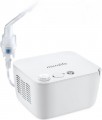Medicine container
The nebuliser's built-in medicine reservoir volume is a crucial consideration. It's important to align this parameter with medical guidelines for the prescribed treatment. A too-small capacity may require frequent refilling, disrupting the treatment process.
Also, knowing the volume of the reservoir and the nebulization rate (see below), it is possible to estimate the operating time of the nebuliser on a single refill.
Nebulization rate
The nebuliser's nebulization capacity per minute.
The ideal nebulization rate can differ based on factors such as the patient's health condition, the type of disease, and the composition of the inhaled medication, as outlined in medical guidelines. This rate is crucial in assessing the inhaler's effectiveness for specific situations and also influences how long the device operates on a single medication refill.
Some models have a nebulization speed control — in such cases, the maximum value is usually indicated in the characteristics.
Medium particle size (MMAD)
Since not all particles have the same size, this paragraph indicates exactly the average, most common particle size when splitting in this inhaler. Accordingly, lower values allow easier and deeper penetration into the bronchi.
Case included
Availability in a set of delivery of an nebuliser of a
case for storage and carrying. The cover provides a certain degree of protection against adverse effects — scratches, bumps, temperature changes, etc. Most often, it can also accommodate additional accessories, primarily nozzles — this reduces the risk of losing any accessory, and, in general, simplifies storage and transportation. This possibility is especially important for pocket models (refer to "Purpose"), the dimensions of which do not allow a special compartment to be provided in the case (see above).
Note that this category also includes models in which the cover is intended only for accessories, and not for the nebuliser itself.

